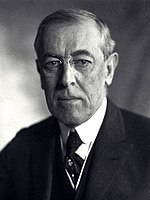| ||||||||||||||||||||||||||
| ||||||||||||||||||||||||||
 County Results
| ||||||||||||||||||||||||||
| ||||||||||||||||||||||||||
| Elections in Indiana |
|---|
 |
The 1916 United States presidential election in Indiana took place on November 7, 1916, as part of the 1916 United States presidential election which was held throughout all contemporary 48 states. Voters chose 15 representatives, or electors to the Electoral College, who voted for president and vice president.
Ever since the Civil War, partisan alliances in Indiana had been related to history of White settlement, with most of Southern Indiana and German-settled counties voting strongly Democratic, opposed to Yankee-settled Northern Indiana which voted Republican.[1] Between the end of the Civil War and the end of the Third Party System, elections in the state were always very close; although the state become more Republican when William Jennings Bryan’s free silver policy drove conservative Democrats to the Republican party for the following two decades.[2] However, only Alton B. Parker would lose the state by more than five percentage points as its strong Southern leanings meant its Democratic counties remained very loyal.[3]
After being won by Woodrow Wilson and running mate Thomas R. Marshall over divided Republican opposition in 1912, Indiana would be won by the Republican nominee, U.S. Supreme Court Justice Charles Evans Hughes of New York, and his running mate Senator Charles W. Fairbanks of Indiana. Hughes and Fairbanks defeated the Democratic nominees, incumbent Democratic President Wilson and Vice President Marshall by a narrow margin of 0.97 percentage points.
Indiana was the home state of Marshall, and alongside Wilson's loss in New Jersey, this election, along with 1968, is the only time a winning presidential and vice presidential candidate lost both of their home states.
This was the first time since 1876 that Indiana voted for the losing candidate, and the first since 1836 that a Democrat won without the state. The election marked the beginning of a trend in which the state was more Republican than the nation as a whole. Before 1916, all but one winning Democrat as well as one losing Democrat had carried the state. Beginning with 1916, the Democratic party has won 14 elections as of 2022, and in only four of these elections did it carry Indiana. Furthermore, three of those four victories were in landslide elections with double-digit margins: 1932, 1936, and 1964.
- ^ Phillips, Kevin P.; The Emerging Republican Majority, p. 343 ISBN 9780691163246
- ^ Phillips; The Emerging Republican Majority, p. 352
- ^ Menendez, Albert J. (2005). The Geography of Presidential Elections in the United States, 1868-2004. McFarland. p. 37. ISBN 0786422173.

